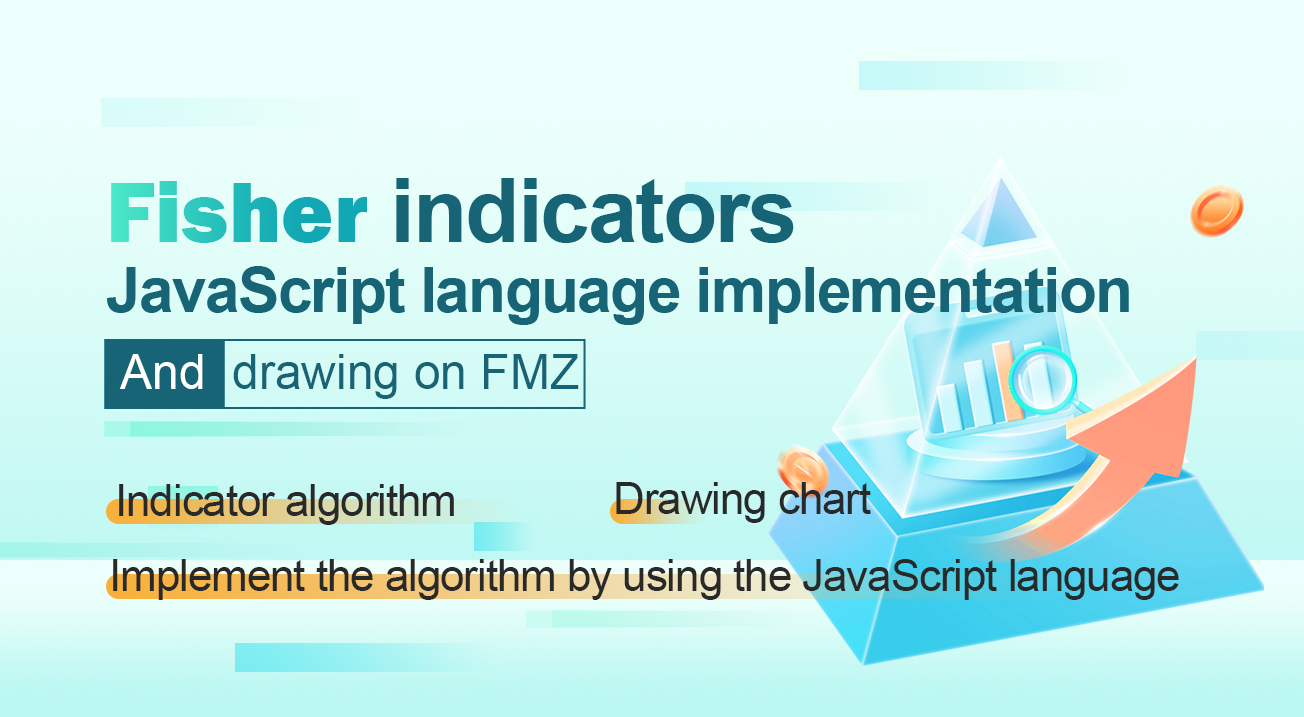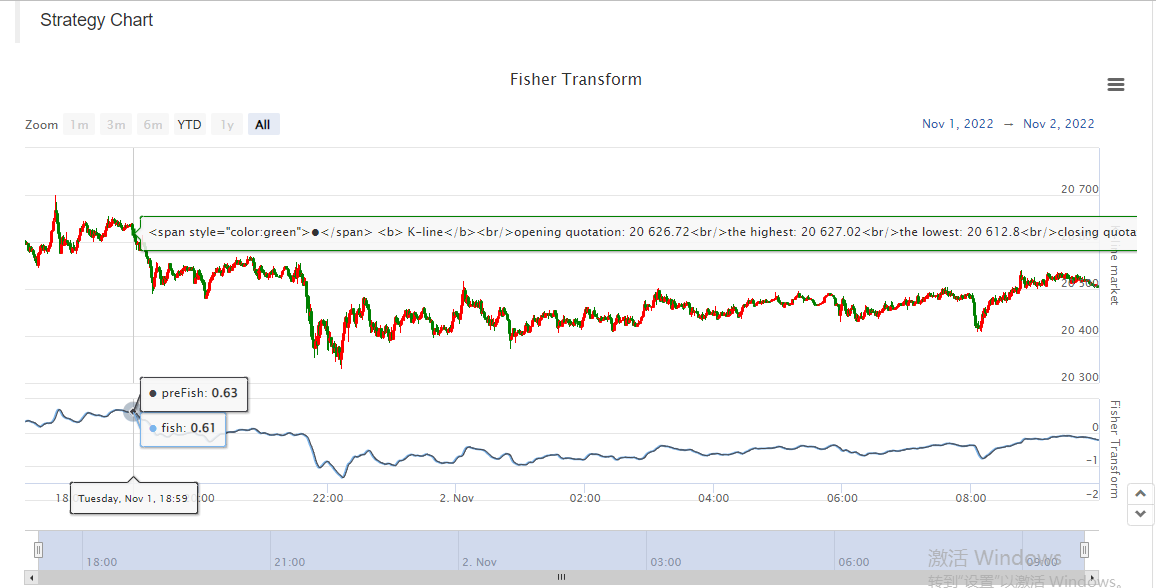Implementação da linguagem JavaScript dos indicadores de Fisher e desenho no FMZ
Autora:FMZ~Lydia, Criado: 2022-11-07 11:37:48, Atualizado: 2024-12-02 21:42:27
Durante a análise técnica da negociação, os comerciantes analisam e estudam os dados do preço das ações como os dados da distribuição normal.Fisher Transformationé um método que pode transformar dados de preços em distribuição normal.Fisher TransformationOs sinais de negociação podem ser enviados utilizando os indicadores do dia em curso e do dia anterior.
Há muitos conteúdos sobre oFisher TransformEm Baidu, Zhihu, aqui não vamos repetir.
Algoritmo do indicador:
-
Preço médio hoje:
mid=(low + high) / 2 -
Julgue o período de cálculo, que pode ser de 10 dias.
lowestLow = lowest price in the period,highestHigh = highest price in the period. -
Definir o parâmetro de variação de preço (o parâmetro de variação de preço)
ratioé uma constante entre 0 e 1, por exemplo, 0,5 ou 0,33):
-
Utilizando o
Fishertransformação no parâmetro de variação de preçox, oFisherO indicador é obtido:
Implementar o algoritmo usando a linguagem JavaScript
É implementado passo a passo de acordo com o algoritmo do indicador.preXepreFish, eles foram definidos para 0 no início.Math LogAlém disso, o algoritmo acima não mencionou a correção de x, que eu quase ignorei quando escrevi:
Corrigir o valor de x, forçá-lo a ser 0,999 se for maior que 0,99.
if (x > 0.99) {
x = 0.999
} else if (x < -0.99) {
x = -0.999
}
A primeira vez que vi o algoritmo e os indicadores, eu os transplantei de acordo com o algoritmo. Eu não verifiquei essa implementação, e alguns que estão interessados em pesquisa podem verificar se há erros.
Fisher TransformCódigo de origem do algoritmo do indicador:
function getHighest(arr, period) {
if (arr.length == 0 || arr.length - period < 0) {
return null
}
var beginIndex = arr.length - period
var ret = arr[beginIndex].High
for (var i = 0 ; i < arr.length - 1 ; i++) {
if (arr[i + 1].High > ret) {
ret = arr[i + 1].High
}
}
return ret
}
function getLowest(arr, period) {
if (arr.length == 0 || arr.length - period < 0) {
return null
}
var beginIndex = arr.length - period
var ret = arr[beginIndex].Low
for (var i = 0 ; i < arr.length - 1 ; i++) {
if (arr[i + 1].Low < ret) {
ret = arr[i + 1].Low
}
}
return ret
}
function calcFisher(records, ratio, period) {
var preFish = 0
var preX = 0
var arrFish = []
// When the length of K-line is not enough to meet the period
if (records.length < period) {
for (var i = 0 ; i < records.length ; i++) {
arrFish.push(0)
}
return arrFish
}
// traverse the K-line
for (var i = 0 ; i < records.length ; i++) {
var fish = 0
var x = 0
var bar = records[i]
var mid = (bar.High + bar.Low) / 2
// When the current BAR is insufficient in period calculation
if (i < period - 1) {
fish = 0
preFish = 0
arrFish.push(fish)
continue
}
// Calculate the highest and lowest price in the period
var bars = []
for (var j = 0 ; j <= i ; j++) {
bars.push(records[j])
}
var lowestLow = getLowest(bars, period)
var highestHigh = getHighest(bars, period)
// price change parameters
x = ratio * 2 * ((mid - lowestLow) / (highestHigh - lowestLow) - 0.5) + (1 - ratio) * preX
if (x > 0.99) {
x = 0.999
} else if (x < -0.99) {
x = -0.999
}
preX = x
fish = 0.5 * Math.log((1 + x) / (1 - x)) + 0.5 * preFish
preFish = fish
arrFish.push(fish)
}
return arrFish
}
Diagrama de desenho
É fácil desenhar no FMZ, na Praça da Estratégia:https://www.fmz.com/squaretem um grande número de exemplos para referência, você pode pesquisar neles.
var cfg = { // The object used to initialize chart settings (i.e. chart settings)
plotOptions: {
candlestick: {
color: '#d75442', // color value
upColor: '#6ba583' // color value
}
},
title: { text: 'Fisher Transform'}, //title
subtitle: {text: ''}, //sub-title
plotOptions: {
candlestick: {
tooltip: {
pointFormat:
'<span style="color:{point.color}">\u25CF</span> <b> {series.name}</b><br/>' +
'opening quotation: {point.open}<br/>' +
'the highest: {point.high}<br/>' +
'the lowest: {point.low}<br/>' +
'closing quotation: {point.close}<br/>'
}
}
},
yAxis: [{
title: {
text: 'K-line market'
},
height: '70%',
lineWidth: 1
}, {
title: {
text: 'Fisher Transform'
},
top: '75%',
height: '30%',
offset: 0,
lineWidth: 1
}],
series: [//series
{
type: 'candlestick',
yAxis: 0,
name: 'K-line',
id: 'KLine',
// Control the candle color with downward trend
color: 'green',
lineColor: 'green',
// Control the candle color with upward trend
upColor: 'red',
upLineColor: 'red',
data: []
},{
type: 'line', // Set the current data series type as line
yAxis: 1, // The y-axis used as the y-axis with the index of 0 (a highcharts chart can have multiple y-axes, and the y-axis with the index of 0 is specified here)
showInLegend: true, //
name: 'fish', // Set it according to the parameter label passed in by the function
lineWidth: 1,
data: [], // Data items of data series
tooltip: { // Tooltip
valueDecimals: 2 // The decimal point of the value is reserved for 5 digits
}
},{
type: 'line', // Set the current data series type as line
yAxis: 1, // The y-axis used as the y-axis with the index of 0 (a highcharts chart can have multiple y-axes, and the y-axis with the index of 0 is specified here)
showInLegend: true, //
name: 'preFish', // Set it according to the parameter label passed in by the function
lineWidth: 1,
data: [], // Data items of data series
tooltip: { // Tooltip
valueDecimals: 2 // The decimal point of the value is reserved for 5 digits
}
}
]
}
var chart = Chart(cfg)
function main() {
var ts = 0
chart.reset()
while (true) {
var r = exchange.GetRecords()
var fisher = calcFisher(r, 0.33, 10)
if (!r || !fisher) {
Sleep(500)
continue
}
for (var i = 0; i < r.length; i++){
if (ts == r[i].Time) {
chart.add([0,[r[i].Time, r[i].Open, r[i].High, r[i].Low, r[i].Close], -1])
chart.add([1,[r[i].Time, fisher[i]], -1])
if (i - 1 >= 0) {
chart.add([2,[r[i].Time, fisher[i - 1]], -1])
}
}else if (ts < r[i].Time) {
chart.add([0,[r[i].Time, r[i].Open, r[i].High, r[i].Low, r[i].Close]])
chart.add([1,[r[i].Time, fisher[i]]])
if (i - 1 >= 0) {
chart.add([2,[r[i].Time, fisher[i - 1]]])
}
ts = r[i].Time
}
}
}
}

Portanto, é muito conveniente estudar dados, gráfico de exibição e estratégia de design no FMZ. Aqui acabamos de demonstrar um exemplo, vocês são todos bem-vindos a deixar uma mensagem.
- Introdução à arbitragem de lead-lag em criptomoedas (2)
- Introdução ao suporte de Lead-Lag na moeda digital (2)
- Discussão sobre a recepção de sinais externos da plataforma FMZ: uma solução completa para receber sinais com serviço HTTP em estratégia
- Discussão da recepção de sinais externos da plataforma FMZ: estratégias para o sistema completo de recepção de sinais do serviço HTTP embutido
- Introdução à arbitragem de lead-lag em criptomoedas (1)
- Introdução ao suporte de Lead-Lag na moeda digital
- Discussão sobre a recepção de sinais externos da plataforma FMZ: API estendida VS estratégia Serviço HTTP integrado
- Exploração da recepção de sinais externos da plataforma FMZ: API de extensão vs estratégia de serviços HTTP embutidos
- Discussão sobre o método de teste de estratégia baseado no gerador de tickers aleatórios
- Métodos de teste de estratégias baseados em geradores de mercado aleatórios
- Novo recurso do FMZ Quant: Use a função _Serve para criar serviços HTTP facilmente
- Estratégia de ponto de virada de futuros de moeda digital com dupla EMA (Tutorial)
- Subscrever Nova Estratégia de Ações para Spot de Moeda Digital (Tutorial)
- Realizar uma ideia com 60 linhas de código - Estratégia de pesca no fundo do contrato
- O valor da moeda digital é o valor de todas as moedas em que a moeda é utilizada.
- Projeto de Sistema de Gestão da Sincronização de Encomendas Baseado no FMZ Quant (2)
- Estratégia ATR multiespécies de futuros de moeda digital (tutorial)
- Escrever uma ferramenta de negociação semi-automática usando a linguagem Pine
- Explore o Design de Estratégia de Alta Frequência da Mudança Mágica do LeeksReaper
- Análise da estratégia do LeeksReaper (2)
- A "Magic Double EMA Strategy" dos Veteranos do YouTube
- Exemplo de projeto de estratégia dYdX
- Projeto de Sistema de Gestão da Sincronização de Encomendas Baseado no FMZ Quant (1)
- Análise da estratégia do LeeksReaper (1)
- O montante das posições em risco da derivada deve ser calculado de acordo com o método de classificação da derivada.
- Situação recente e funcionamento recomendado da estratégia de taxa de financiamento
- Revisão do Mercado de Moedas Digitais em 2021 e a Estratégia 10 vezes mais simples perdida
- Modelo de Fator de Moeda Digital
- A estratégia de dupla EMA equilátera é do YouTube.
- Escrever uma ferramenta de negociação semi-automática usando o linguagem Pine
- Modelo de fatores de moeda digital